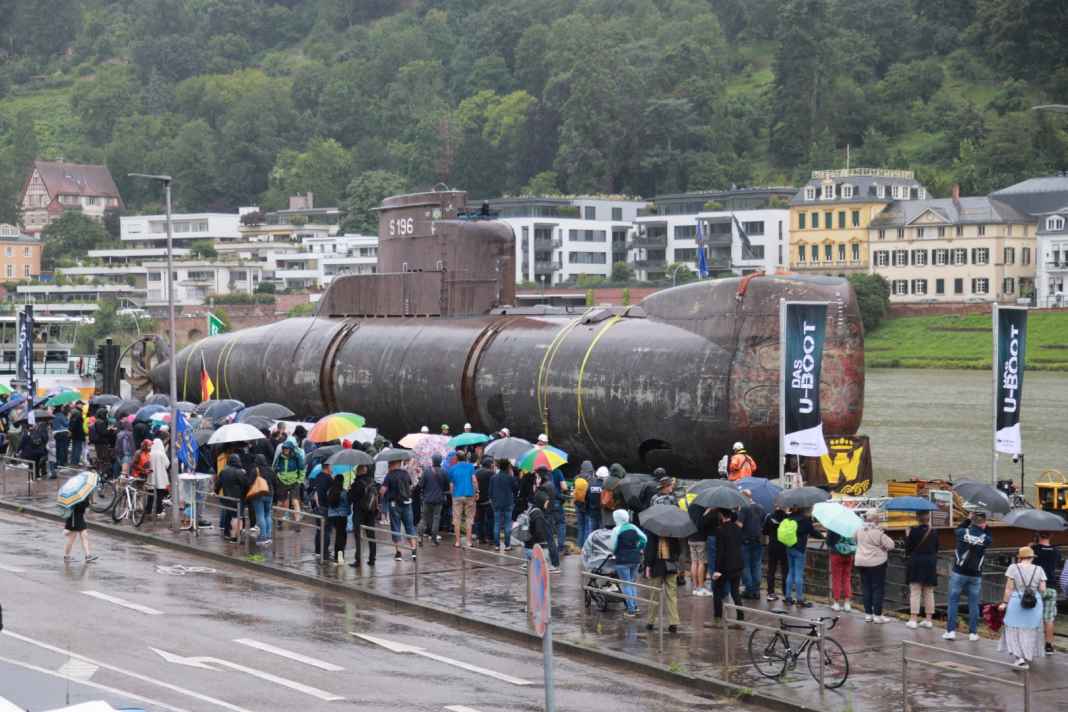




The submarine was tilted on the pontoon using a special turning device
On Friday (5 July), the submarine was turned on the water near Mannheim for the first time. It had to be tilted using a special turning device on the river pontoon in order to be able to pass under the bridges in the direction of Heidelberg. The challenging operation marked an important milestone in the four-week transport. By midday, the convoy weighing several tonnes had moored in front of the Kübler haulage company's premises in Mannheim/Rheinau. After a brief meeting, the transport crew began with the preparations - the test rotations had previously only taken place on land: Loosening the lashings, stowing them neatly and safely, then laying the electrics for the turning device and getting it ready for operation. Then we got started. A unique spectacle for everyone involved: 350 tonnes tipped to one side within a few minutes until U17 came to a halt on the river pontoon at an angle of 76 degrees.
"We are extremely proud of the successful completion of this complex project," said Frieder Saam from Spedition Kübler GmbH. "The cooperation between our workshop team, the freight forwarder and the Van der Wees shipping company, as well as the use of state-of-the-art technology, are crucial to the success of this project," added U17 project manager Michael Einkörn.
Bridge crossing: pontoon had to be weighted down with water
On Saturday (6 July), the convoy then set off for Heidelberg with the push boat "Pieter" Van der Wees and its historic cargo. The next challenge came at the historic Neckar Bridge in Ladenburg: the convoy could only pass exactly under the centre of the bridge arch. The river was not deep enough at the sides. Ben Kik, the captain of the push boat, weighed the pontoon down with water so that it was as deep as possible in the Neckar. After the bridge, he only had a few kilometres to pump the water out of the pontoon and lift it and the U17 out of the river again. There were only a few centimetres left between the bottom of the Neckar and the pontoon. Then the Schwabenheim lock opened its gates. Once again, it was a matter of centimetres on both sides. After the successful lockage, the two landmarks of Heidelberg, the castle ruins and the Old Bridge, were in sight. Despite the rain, around 1000 onlookers gathered along the banks of the Neckar and on the bridges to greet U17.
The last stage of the spectacular transport
Today, Monday morning (8 July), the journey continued to Eberbach. Before passing under the Old Bridge, U17 was once again tilted to one side to pass under the town's landmark. Many onlookers captured this five-minute moment with their mobile phone cameras.
Tomorrow (Tue 9 July), the next stage will be on the Neckar to Haßmersheim. The colossus will then be lifted out of the water and loaded for the approximately two-week road transport. Communities and associations are planning numerous festivals and events along the approximately 50-kilometre road transport route. On Sunday 28 July, the submarine is due to arrive at the Technik Museum in Sinsheim, where it will be on display as an exhibit from next year.
Two million euros for the submarine project
The U17 was in service from 1973 and was decommissioned by the navy in 2010. It was then transported from Kiel to Speyer last year. Hundreds of onlookers followed the transport even then. Since then, U17 has been prepared for onward transport to Sinsheim at the Technik Museum in Speyer: Among other things, the submarine was made 100 tonnes lighter by removing old batteries and weights. In addition, the tilting device was built under the submarine. According to the Technik Museen Sinsheim Speyer, the entire submarine project cost around two million euros and is mainly financed by donations.
Follow submarine transport via livestream and geotracking
The entire U17 route can be found at www.technik-museum.de/u17/#die-strecke can be viewed. Thanks to geo-tracking, it is possible to follow the convoy and estimate when and where it will pass by. For those interested who cannot be there live on site, there is a Livestream. At particularly interesting sections of the route, a presenter accompanies the action and talks to former submariners, among others.
About the Technik Museen Sinsheim Speyer - Technology from underwater to outer space
Supported by the non-profit organisation Auto + Technik Museum Sinsheim e. V., the Technik Museen Sinsheim Speyer have over 5,000 members worldwide. In 2023, the two institutions recorded almost one million visitors. They are financed by admission fees, donations and membership fees from the association's members. The surpluses are used to maintain and expand the museums. Open 365 days a year, the museums display over 6,000 exhibits from all areas of technological history on more than 200,000 m². From submarines to vintage cars, from the Concorde to the Space Shuttle Buran.

